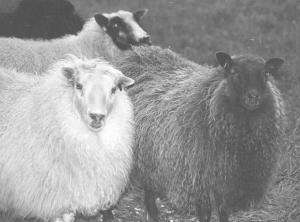1998 - Volume #22, Issue #6, Page #22
[ Sample Stories From This Issue | List of All Stories In This Issue | Print this story
| Read this issue]
Colorful Icelandic Sheep May Catch On Fast
 |
Still rare in North America, Icelandic sheep were developed years ago in Iceland as a meat breed. They're still the only breed in that country.
"Icelandic sheep are not a remnant of a once thriving breed, but a viable commercial breed that numbers 487,000 in Iceland and accounts for 50 percent of the total meat in the diet of the Icelandic people," says Susan.
The 17 colors and patterns include snow white, inky black, cream, tans, and browns ranging from mocha to dark chocolate. They also come as pintos (black and white or brown and white.
The breed was brought to Iceland in the 9th and 10th century by early Viking settlers. The ancient ancestors of these naturally short-tailed animals dominated Scandinavia and the British Isles 1,200 to 1,300 years ago. Be-cause Iceland was relatively isolated, the sheep that were originally brought there remained virtually unchanged.
The Mongolds say there are plenty of reasons to raise these medium sized sheep. "They have excellent meat conformation, produce colorful, lusterous, versatile fleece, have few lambing problems, mature early, and produce twins reliably. But best of all, they thrive on grass and hay alone," says Susan. "This breed is ideal for pasture lambing, and the lambs finish on grass in 4 to 5 months so they don't have to be castrated.
"Icelandic meat is fine grained, light flavored (not strong or muttony flavored), and known worldwide for its gourmet quality. They will reach their ideal slaughter weight of 90 to 100 lbs. in 4 to 5 months. The breed is hardy and disease resistant. Because they have naturally short tails, their tails don't have to be docked. The ewes lamb easily, are excellent mothers and heavy milkers. The lambs are vigorous and jump up quickly to nurse and make gains of 3/4 to 1 lb. day on mother's milk and grass alone. No creep feed is necessary. Ewes are long lived and will produce into their 13th year.
"Both rams and ewes can be horned or polled. Horned rams grow outwardly curving horns that will make a double curl as they get older. Horned ewes have a simple back-ward sweeping 1/2 circle curl."
Icelandic sheep are dual coated with a long outer coat called Tog that grows to 18 in. if left to grow for one year, providing wind and rain protection; and a fine, soft, downy undercoat called Thel that provides warmth. Today Icelandic yarn is a high priced luxury fiber sold in yarn shops for ski sweather yarn and other such uses. It's also sold as expensive hand-knitted sweaters made in Iceland from an unspun roving called lopi. The fleece is prized by hand spinners and sells for as much as $27 per pound.
The Icelandic breed also leads the world market in quality pelts. The pelts look and feel like fur and sell for $90 to $130 and are used by the garment industry and interior decorators. Their fleeces have fewer follicles which produces a stronger, more pliable pelt which looks more like fur than a sheepskin. Breeding stock sells for $700 to $1,000. For fleece samples and more information, send a SASE with two stamps.
Contact: FARM SHOW Followup, Rex and Susan Mongold, HC 40 Broadus Stage, Miles City, Mont. 59301 (ph 406 232-2819). For color photos and more information check their Web site at http://www.icelandic.com

Click here to download page story appeared in.

Click here to read entire issue
To read the rest of this story, download this issue below or click here to register with your account number.




